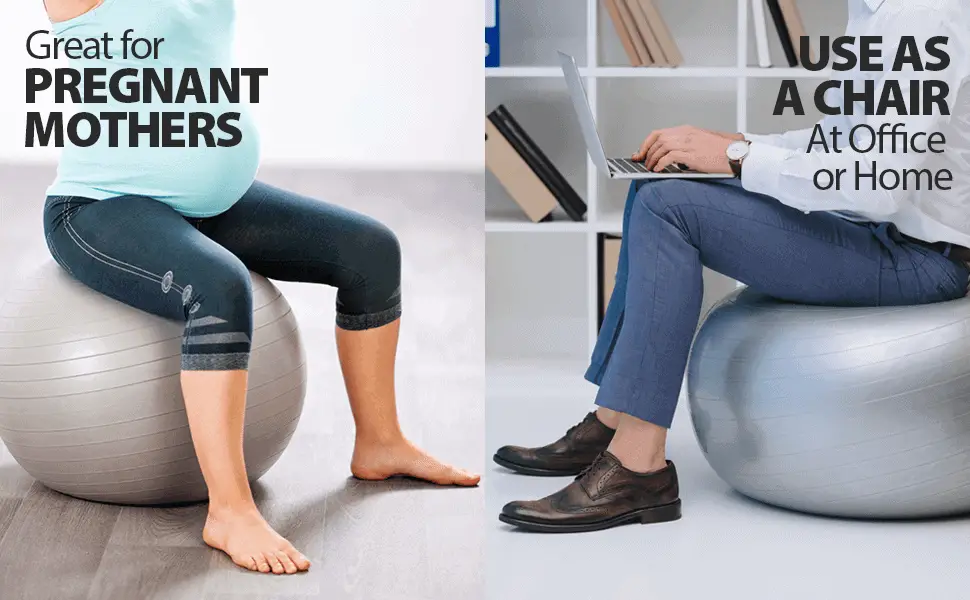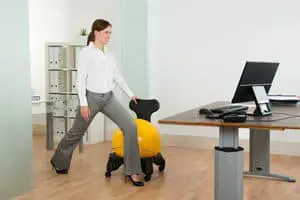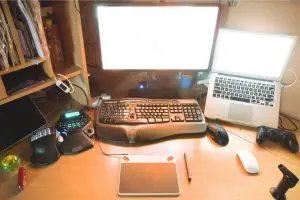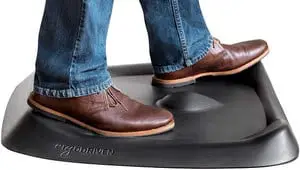One of the newest trends in office ergonomics is using exercise balls to replace office chairs. While the overall benefits are still debatable, switching things up using these colorful stability balls can be a fun way to promote healthy activities at the office.
What size exercise ball is best for sitting at the desk? Use a 26-inch (65 cm) exercise ball if your desk is an industry-standard height of 30 inches (76 cm). Additionally, choose a ball that is 4 inches (10 cm) taller than the height of the chair you’re replacing because the ball will deflate once you sit on it.
It’s important to note, however, the above size is just a general recommendation. There are many factors in choosing the right size. In this post, we’ll take a closer look at choosing the best exercise ball size using the Exercise Ball Size Chart. That way, you can achieve proper balance and stability when sitting at your desk.
All content and media on Office Solution Pro are created and published online for informational purposes only. It is not intended as a substitute for professional medical advice and should not be relied on as health or personal advice. This post may contain affiliate links.
Which Size Exercise Ball Should I Buy?
Exercise balls are measured in centimeters and come in five industry-standard sizes: 45 cm, 55 cm, 65 cm, 75 cm, and 85 cm. These measurements indicate the height of the ball once it’s fully inflated. For general exercise applications, the most common ball size is the 65 cm ball, best used for anyone between 5’9” to 6’2” tall.
To choose the best fitness ball size, measure the distance between the floor and your knees. That’s the size you want to go for. If your knee measurement is between ball sizes, buy the larger ball and under-inflate it. Your hips and knees should bend at a 90-degree angle when you sit on the ball.
Exercise Ball Size Chart
Hard-to-find 85 cm exercise balls are ideal for individuals over 6’8” tall. To make things easier for you, use the chart below to choose the correct exercise ball size based on your height:
|
Person’s Height |
Exercise Ball Diameter |
|---|---|
|
5′ and under |
XSMALL 45 cm (17 inches) |
|
5’1″ – 5’8″ |
SMALL 55 cm (22 inches) |
|
5’9″ – 6’2″ |
MEDIUM 65 cm (26 inches) |
|
6’3″ – 6’7″ |
LARGE 75 cm (30 inches) |
|
6’8″ and taller |
XLARGE 85 cm (35 inches) |
While the above chart is for general exercise purposes, choosing the ideal ball size for an office chair is slightly different. The University of Minnesota Extension recommends using an exercise ball that is one size larger for sitting at a desk. This is because the ball will deflate slightly when sitting on it.
To be honest with you, we don’t recommend using an exercise ball as a permanent replacement for office chairs. An exercise ball is better suited to switch things up every once in a while. If you want to focus on producing high-quality work, you’ll find better comfort by choosing the right ergonomic office chair.
However, if you want to give exercise balls a try, be sure to find one from a reputable brand. We found one equipped with an anti-burst coating and a non-slip surface. It also comes with a free workout guide and simple instructions for you to follow along. You can check out this exercise ball here (link to Amazon).
How Much Do I Inflate My Exercise Ball?
The best way to know that you’ve inflated your exercise ball properly is to measure the height once it’s fully inflated. Here are the simple steps to achieve the right measurements when inflating an exercise ball:
- Make a pencil mark on the wall – depending on your exercise ball, use a pencil to mark either 22 inches, 26 inches, or 30 inches on the wall.
- Inflate the ball – use the pencil mark to match the height of your exercise ball. Once the ball reaches the mark, it’s fully inflated.
- Don’t over-inflate the ball – the exercise ball can burst if inflated more than its indicated size.
Remember, the harder the ball, the more difficult it is to use for yoga and exercise. If you suffer from lower back or hip problems or have longer legs, it’s best to choose a larger ball size. This will ensure that you achieve equal weight distribution while having both feet flat on the ground.


Businesswoman Leaning On Chair With Fitness Ball While Working On Computer
The Benefits of Using an Exercise Ball to Workout
There are a lot of benefits to working out on an unstable surface. The first one is that it forces your core muscles to put in even more work into keeping you balanced and boosting your core strength. A flat surface may not keep your abdominals engaged as much.
According to a study in 2007, crunches on the right size stability ball fires up the muscles in your core more than performing them on a level surface. This makes exercise ball activities great additions to your fitness routine. Plus, they do an excellent job of easing the tension on your hamstrings and lower back.
It is, however, important to take things slow the first time you use the ball to avoid hurting yourself. Start with simple body workout routines using the correct size ball that suits your fitness level and body weight and move forward from there.
Related Questions to Exercise Ball Sizes
1. Is it healthy to sit on an exercise ball at work?
While there are some benefits to using an exercise ball as an office chair (including burning four calories per hour), the disadvantages far outweigh the advantages. In general, you can use the exercise ball for sitting. Whether the ball is high enough for you depends on several factors, including your desk height.
Many exercise ball users have reported less comfort when compared to using a regular office chair. We’ve researched this issue and wrote an article busting the myths surrounding the benefits (or non-benefits) of using exercise balls for chairs. You can read our article right here.
2. How long should you sit on an exercise ball at work?
If you decide to sit on an exercise ball at work, the best time to spend sitting is around 20 minutes per session. When using the ball for the first time, you need time to get used to it. This is a good thing because sitting for more than 20 minutes at a time may cause harm to your health in the long run.
Sitting for too long is bad for you. Period. It doesn’t matter if you’re sitting in an exercise ball or an office chair. We recommend using the exercise ball to alternate with the office chair. The goal is to promote less sitting time and more activity during work hours.
3. Does sitting on an exercise ball help with sciatica?
No, sitting on an exercise ball will not help sciatica. Because of the unstable nature of the balls, finding proper balance can be a challenge. Not to mention, you won’t find back support when sitting on an exercise ball. Many early adopters have reported increased pain, specifically in the lower back region.
If you’re dealing with sciatica, learning to sit correctly is important to find comfort, especially when you are required to sit at work. We’ve created a comprehensive guide to help sciatica sufferers during work to help achieve maximum productivity. You can check out our article right here.
Final Takeaways
And there you have it, a simple guide to answer the question: what size exercise ball is best for sitting at a desk? Not only is choosing the right size important for your comfort, but it’s also important to prevent unwanted injuries. Remember to buy one from a reputable brand if you try it out.
In all honesty, we can’t see the advantage of using an exercise ball as an office chair. If your biggest concern is finding the proper sitting posture, you’re better off finding the right ergonomic office chair. Most options nowadays are relatively affordable and come with features designed to maximize your posture.
If you do insist on using an exercise ball, however, always turn to the exercise ball size chart for guidance. More importantly, remember to stay active and regularly move to help fight the negative effects of a sedentary lifestyle. We hope you find health and fulfillment wherever you are.
Citations
Sternlicht E, Rugg S, Fujii LL, Tomomitsu KF, Seki MM. Electromyographic comparison of a stability ball crunch with a traditional crunch. J Strength Cond Res. 2007 May;21(2):506-9. doi: 10.1519/R-20436.1. PMID: 17530978.







